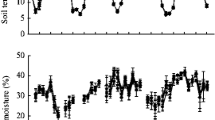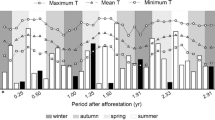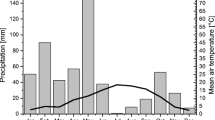Abstract
With the implementation of the Chinese Natural Forest Conservation Program (NFCP) in 1998, over millions of hectares of forest in northeastern China have been protected through natural restoration (closure of hills). The impact of this program on the carbon budget of soil has not been evaluated until now. This paper presents results from a 6-year study of total CO2 efflux from both soil and litter (R total), CO2 flux from soil (R soil), soil organic matter (SOM), soil microbe density, and litter input and root biomass at an uncut larch (Larix gmelinii) forest and at a natural restoration site. The natural restoration area is a clear-cut site that was formerly part of a continuous portion of the uncut larch forest. Our objectives were to: (1) quantify the magnitude of CO2 efflux from typical sites in northeastern China; (2) explore the changes in thermal conditions, SOM, and annual CO2 flux during the 6-year natural restoration, and (3) evaluate the impact of NFCP on soil carbon processes. The annual R soil at the clear-cut site (58.6–68.2 mol m − 2 year − 1) was 113.6–228.4% (mean 141.5%) higher than that at the uncut larch site (29.6–58.4 mol m − 2 year − 1). At the same time, annual CO2 from litter at the clear-cut site (2.0–14.2 mol m − 2 year − 1) was only 23.5–84.5% (mean 52.5%) of that at the uncut larch site (5.4–16.8 mol m − 2 year − 1). SOM at the surface layer of the clear-cut site was 75% of that at the uncut larch site, but the soil microbial biomass (carbon) at the clear-cut site was much higher than that at the larch site (p < 0.05). The percentage of bacteria, fungi and actinomycetes also were largely different between both sites. Natural restoration at the clear-cut site strongly affected thermal conditions. Although the soil temperature (T soil) and effective accumulated \(T_{\rm soil} > 0^{\circ}\)C at the clear-cut site was much higher, the temperature sensitivity (Q 10) was much lower than that at the uncut larch site, and their differences decreased linearly from 2001 to 2006 (p < 0.05). Moreover, Q 10 at the clear-cut site significantly increased with the progress of natural restoration, which diminished the Q 10 difference between the two sites (slope = − 0.2792, r 2 = 0.4744, p < 0.05). These data imply that the NFCP natural restoration process has positively recovered the thermal condition of the clear-cut site to the level of uncut larch forest during the 6-year period. However, linear regression analysis showed that the 6-year natural restoration only slightly affected the annual soil CO2 efflux and SOM at both sites, and also did not diminish the differences between the two sites (p > 0.10), indicating that a much longer time is necessary to restore the soil carbon in the clear-cut site.
Similar content being viewed by others
References
BFIH (Bureau in general of the Forestry Industries of Heilongjiang province, P. R. China) (2001) Implementing blueprint of the Natural Forest Conservation Program in the National Forest region of Forestry Industries of Heilongjiang Province (in Chinese)
Boone RD, Nadelhoffer KJ, Canary JD et al (1998) Roots exert a strong influence on the temperature sensitivity of soil respiration. Nature 396:570–572
Bowden RD, Nadelhoffer KJ, Boone RD et al (1993) Contributions of above ground litter, below ground litter, and root respiration to total soil respiration in a temperate mixed hardwood forest. Can J For Res 23:1402–1407
Busse MD, Beattie SE, Powers RF et al. (2006) Microbial community responses in forest mineral soil to compaction, organic matter removal, and vegetation control. Can J For Res 36:577–588
Catricala CE, Newkirk KM, Steudler PA et al (1997) Effect of soil warming on microbial and root respiration. Agron J-Abstracts 284
Chen XY, Hutley LB, Eamus D (2003) Carbon balance of a tropical savanna of northern Australia. Oecologia 137:405–416
Cisneros Dozal LM, Trumbore S et al (2004) Quantifying sources of soil respiration using 14C-enriched leaf litter and roots in a temperate forest. http://ebis.ornl.gov/CisnerosP1.pdf
Covington WW (1981) Changes in forest floor organic matter and nutrient content following clear cutting in northern hardwoods. Ecology 62:41–48
Davidson EA, Ackerman IL (1993) Changes in soil carbon inventories following cultivation of previously untilled soils. Biogeochemistry 20:161–193
Davidson EA, Belk E, Boone RD (1998) Soil water content and temperature as independent or confounded factors controlling soil respiration in a temperate mixed hardwood forest. Glob Chang Biol 4:217–227
Davidson EA, Janssens IA (2006) Temperature sensitivity of soil carbon decomposition and feedbacks to climate change. Nature 440:165–173
Fierer N, Colman BP, Schime JP et al (2006) Predicting the temperature dependence of microbial respiration in soil: A continental-scale analysis. Glob Biogeochem Cycles 20:GB3026. doi:10.1029/2005GB002644
Fleming RL, Laporte MF, Hogan GD et al (2006) Effect of harvesting and soil disturbance on soil CO2 efflux from a jack pine forest. Can J For Res 36:589–600
Giardina CP, Ryan MG (2000) Evidence that decomposition rates of organic carbon in mineral soil do not vary with temperature. Nature 404:858–861
Gordon AM, Schlentner RE, Van CK (1987) Seasonal patterns of soil respiration and CO2 evolution following harvesting in the white spruce forests of interior Alaska. Can J For Res 17:304–310
Gower ST, Richards JH (1990) Larches: deciduous conifers in an evergreen world—in their harsh environments, these unique conifers support a net carbon gain similar to evergreens. BioScience 40:818–826
Gu JC, Wang ZQ, Han YZ et al (2006) Effects of cutting intensity on spatial heterogeneity of topsoil temperature in secondary forest in Maoershan region of Heilongjiang Province. Chinese J Appl Ecol 17:2248–2254 (in Chinese)
Gu LH, Hanson PJ, Post WM, Liu Q (2008) A novel approach for identifying the true temperature sensitivity from soil respiration measurements. Glob Biogeochem Cycles 22:GB4009
Hannam KD, Quideau SA, Kishchuk BE (2006) Forest floor microbial communities in relation to stand composition and timber harvesting in northern Alberta. Soil Biol Biochem 38:2565–2575
Hendrickson Q, Chatarpaul L, Burgess D (1989) Nutrient cycling following whole-tree and convention harvest in northern mixed forest. Can J For Res 19:725–735
Houghton RA, Woodwell GM (1989) Global climate change. Sci Am 260:36–44
Houghton RA, Hackler JL (2000) Changes in terrestrial carbon storage in the United States. 1: the roles of agriculture and forestry. Glob Ecol Biogeogr 9:125–144
Houston APC, Visser S, Lautenschlager RA (1998) Microbial processes and fungal community structure in soils from clear-cut and unharvested areas of two mixedwood forests. Can J Bot 76:630–640
Hu HB, Guo ZG, Peng CH (2003) Land use induced changes of organic carbon storage in soils of China. Glob Chang Biol 9:305–315
Irvine J, Law BE (2002) Contrasting soil respiration in young and old-growth ponderosa pine forests. Glob Chang Biol 8:1183–1194
Janssens IAH, Lankreijer G, Matteucci AS et al (2001) Productivity overshadows temperature in determining soil and ecosystem respiration across European forests. Glob Chang Biol 7:269–278
Jenkinson DS, Powlson DS (1976) The effects of biocidal treatments on metabolism in soil—V. A method for measuring soil biomass. Soil Biol Biochem 8:209–213
Johnson DW (1992) Effects of forest management on soil carbon storage. Water Air Soil Pollut 64:83–120
Johnson DW, Curtis PS (2001) Effects of forest management on soil C and N storage: meta analysis. For Ecol Manag 140:227–238
Kane ES, Pregitzer KS, Burton AJ (2003) Soil respiration along environmental gradients in Olympic National Park. Ecosystems 6:326–335
Kirschbaum MUF (1995) The temperature dependence of soil organic matter decomposition and the effect of global warming on soil organic carbon storage. Soil Biol Biochem 27:753–760
Kirschbaum MUF (2006) The temperature dependence of organic-matter decomposition—still a topic of debate. Soil Biol Biochem 38:2510–2518
Koike TK, Yazaki R, Funada Y et al (2000) Forest health and vitality in northern Japan: a history of larch plantation. Res Notes Fac For, Univ Joensuu 92:49–60
Laporte MF, Duchesne LC, Morrison IK (2003) Effect of clearcutting, selection cutting, shelterwood cutting and microsites on soil surface CO2 efflux in a tolerant hardwood ecosystem of northern Ontario. For Ecol Manag 174:565–575
Lavigne MB, Boutin R, Foste RJ et al. (2003) Soil respiration responses to temperature are controlled more by roots than by decomposition in balsam fir ecosystems. Can J For Res 33:1744–1753
Lee MK, Nakane T, Nakatsubo WM et al (2001) Effects of rainfall events on soil CO2 flux in a cool temperate deciduous broad-leaved forest. Ecol Res 17:401–409
Lin QM, Wu YG, Liu HL (1999) Modification of fumigation extraction method for measuring soil microbial biomass carbon. Chinese J Ecol 18:63–66 (in Chinese)
Liu BH, Xu M, Henderson M, Qi Y, Li YQ (2004) Taking China’s temperature: daily range, warming trends, and regional variations, 1955–2000. J Climate 17:4453–4462
Londo AJ, Messina MG, Schoenholtz SH (1999) Forest harvesting effects on soil temperature, moisture, and respiration in a bottomland hardwood forest. Soil Sci Soc Am J 63:637–644
Lu WD (1993) Larch resources and their utilization. NE Forestry University Press, Harbin, p 176 (in Chinese)
Luo YS, Wan D, Hui L et al (2001) Acclimatization of soil respiration to warming in a tall grass prairie. Nature 413:622–625
Mallik AU, Hu D (1997) Soil respiration following site preparation treatments in boreal mixedwood forest. For Ecol Manage 97:265–275
Marra JL, Edmonds R (1996) Coarse woody debris and soil respiration in a clearcut on the Olympic Peninsula, Washington, USA. Can J For Res 26:1337–1345
Martin JL, Gower ST, Plaut J et al (2005) Carbon pools in a boreal mixed wood logging chronosequence. Glob Chang Biol 11:1883–1894
Mattson KG, Smith HC (1993) Detrital organic matter and soil CO2 efflux in forests regenerating from cutting in West Virginia. Soil Biol Biochem 25:1241–1248
Mikola J, Barker GM, Wardle DA (2000) Linking aboveground and belowground effects in autotrophic microcosms: effects of shading and defoliation on plant and soil properties. Oikos 89:577–587
Musselman RC, Fox DG (1991) A review of the role of temperate forests in the global CO2 balance. J Air Waste Manage 41:798–807
Nakane KT, Kohno T, Horikoshi T (1996) Root respiration rate before and just after clear-felling in a mature, deciduous, broad-leaved forest. Ecol Res 11:111–119
NEFU (1984) Basic data for Maoershan experimental forests of Northeast Forestry University (NEFU). NEFU, Harbin, p 163
Nelson DW, Sommers LE (1982) Total carbon, organic carbon, and organic matter. In: Page AL et al (eds) Methods of soil analysis. Part 2, 2nd edn. Agron Monogr 9. ASA and SSSA, Madison, pp 539–580
Pandey A, Palni LMS (1996) The rhizosphere effect of tea on soil microbes in Himalayan monsoonal location. Biol Fertil Soils 21:131–137
Pennanen T, Liski J, Baath E et al (1999) Structure of the microbial communities in coniferous forest soils in relation to site fertility and stand development stage. Microb Ecol 38:168–179
Pumpanen J, Westman CJ, Llveeniemil H (2004) Soil CO2 efflux from a podzolic forest soil before and after clear-cutting and site preparation. Boreal Environ Res 9:199–212
Raich JR, Schlesinger WH (1992) The global carbon dioxide flux in soil respiration and its relationship to vegetation and climate. Tellus B 44:81–99
Rey AE, Pegoraro V, Tedeschi I et al (2002) Annual variation in soil respiration and its components in a coppice oak forest in Central Italy. Glob Chang Biol 8:851–866
Schilling EB, Lockaby BG, Rummer R (1999) Belowground nutrient dynamics following three harvest intensities in the Pearl River floodplain, Mississippi. Soc Sci Am J 63:1856–1868
Schulze ED, Lloyd J, Kelliher FM et al (1999) Productivity of forests in the Eurosiberia boreal region and their potential to act as a carbon sink—a synthesis. Glob Chang Biol 5:703–722
Schwendenmann LE, Veldkamp T, Brenes JJ et al (2003) Spatial and temporal variation in soil CO2 efflux in an old-growth neotropical rain forest, La Selva, Costa Rica. Biogeochemistry 64:111–128
SFAC (Sate Forestry Administration, P.R. China) (2000) Introduction of the Natural Forest Conservation Programme. http://www.tianbao.net/gcjj/gcjj_02.asp
Startsev NA, McNabb DH, Startsev AD (1998) Soil biological activity in recent clearcuts in west-central Alberta. Can J Soil Sci 78:69–76
Striegl RG, Wickland KP (1998) Effects of a clear-cut harvest on soil respiration in a jack pine-lichen woodland. Can J For Res 28:534–539
Subke JA, Reichstein M, Tenhunen JD (2003) Explaining temporal variation in soil CO2 efflux in a mature spruce forest in Southern Germany. Soil Biol Biochem 35:1467–1483
Tang JW, Ye Q, Xu M, Misson L, Goldstein AH (2005) Forest thinning and soil respiration in a ponderosa pine plantation in the Sierra Nevada. Tree Physiol 25:57–66
Tate RL III (2000) Soil microbiology, 2nd edn. Wiley, New York, p 508
Toland DE, Zak DR (1994) Seasonal patterns of soil respiration in intact and clear-cut northern hardwood forests. Can J For Res 24:1711–1716
Wang WJ, Zu YG, Wang HM et al (2005) Plant Biomass and productivity of Larix gmelinii forest ecosystems in Northeast China: intra- and inter-species comparison. Eurasian J For Res 8:21–41
Wang CK, Yang JY, Zhang QZ (2006) Soil respiration in six temperate forests in China. Glob Chang Biol 12:2103–2114
Weber MG (1990) Forest soil respiration after cutting and burning in immature aspen ecosystems. For Ecol Manag 31:1–14
Xu M, Ye Q, Peng G (2000) China’s forest policy for the 21st century. Science 289:2049–2050
Zhang PC, Zhou XF, Wang FY (1999) Conspectus of natural forest conservation program in China. China Forestry Press, Beijing, p 388 (in Chinese)
Zhang PC, Shao GF, Zhao G et al (2000) China’s forest policy for the 21st century. Science 288:2135–2136
Zhang Y, Zhang X, Liu X et al (2006) Microarray-based analysis of changes in diversity of microbial genes involved in organic carbon decomposition following land use/cover changes. FEMS Microbiol Lett 266:144–151
Zhong Z, Makeschin F (2003) Soil biochemical and chemical changes in relations to mature spruce (Picea abies) forest conversion and regeneration. J Plant Nutr Soil Sci 166:291–299
Zhou DQ (1986) Microbiology experimental manual. Shanghai Science and Technology Press, Shanghai, p 574 (in Chinese)
Zhou XF (1999) China forest and ecological environment. China Forestry Publishing, Beijing, p 540 (in Chinese)
Zhou SX (2001) Hopeful 10 year: the leap-forward developing plan of China forestry in the new era. China Forestry Publishing, Beijing, p 420 (in Chinese)
Zu YG, Gao CY, Wang WJ et al (2007) Characteristics of the microbial community in rhizosphere of Camptotheca acuminata cultured with exotic invasive plant Eupatorium adenophorum. Sci China, Ser C Life Sci 50:22–30
Author information
Authors and Affiliations
Corresponding author
Rights and permissions
About this article
Cite this article
Zu, YG., Wang, WJ., Wang, HM. et al. Soil CO2 efflux, carbon dynamics, and change in thermal conditions from contrasting clear-cut sites during natural restoration and uncut larch forests in northeastern China. Climatic Change 96, 137–159 (2009). https://doi.org/10.1007/s10584-009-9601-7
Received:
Accepted:
Published:
Issue Date:
DOI: https://doi.org/10.1007/s10584-009-9601-7




